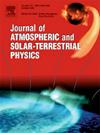Influence of land use land cover and topography on lightning distribution over north and north-east Indian region
IF 1.8
4区 地球科学
Q3 GEOCHEMISTRY & GEOPHYSICS
Journal of Atmospheric and Solar-Terrestrial Physics
Pub Date : 2025-02-08
DOI:10.1016/j.jastp.2025.106460
引用次数: 0
Abstract
Spatio-temporal variation of lightning characteristics over North India (NI) and North-East India (NEI) during the period 2001–2014 is studied in connection with the land use land cover (LULC) and topography of the Himalaya ranges. Lightning flashes detected by Lightning Imaging Sensor (LIS) on board the Tropical Rainfall Measuring Mission (TRMM) satellite are analysed for different LULC classes measured by Moderate Resolution Imaging Spectroradiometer (MODIS) and elevation data from Shuttle Radar Topography Mission (SRTM). We observed that the annual lightning flashes are high in the NI region compared to the NEI region; with a peak during monsoon period in the NI region, whereas peaks in the NEI were found to be during pre-monsoon months. The thermodynamics parameters such as maximum temperature (MaxT), convective available potential energy (CAPE), latent heat flux (LHF) and bulk microphysics such as total cloud cover liquid water (TCCLW) and total cloud cover ice water (TCCIW) along with lightning flash rate density (LFRD) also analysed with respect to different LULC classes. The impact of LULC on lightning activity is evident in both the study regions. In the both the region, human-induced landscapes such as croplands, urban built-up areas consistently show the high lightning activity due to favourable thermodynamic and microphysical conditions. Natural landscapes such as forest, grasslands show moderate lightning activity while savannas and permanent wetlands shows high lightning activity showing that vegetation helps in maintaining high soil moisture which may play a significant role in lightning occurrences. Topography significantly influenced lightning occurrence, with higher flash rates in foothill areas due to surface heating and moisture convergence, and in Meghalaya due to orographic lifting. Lightning activity in both study regions is higher at lower altitudes (<500m) and decreases with altitude, with a more prominent decline in case of NI region. We found the positive lightning trends in areas of expanding agriculture and urbanization highlighting the role of LULC change in the lightning distribution over both the regions.
土地利用、土地覆盖和地形对印度北部和东北部地区闪电分布的影响
研究了2001-2014年印度北部(NI)和印度东北部(NEI)闪电特征的时空变化与喜马拉雅山脉土地利用、土地覆盖和地形的关系。摘要对热带降雨测量任务(TRMM)卫星上的闪电成像传感器(LIS)探测到的闪电进行了分析,并利用中分辨率成像光谱仪(MODIS)和航天飞机雷达地形测量任务(SRTM)的高程数据对不同的LULC等级进行了分析。我们观察到,NI地区的年闪电次数比NEI地区高;东北东北地区的峰值出现在季风期,而东北东北地区的峰值出现在季风前月份。分析了最高温度(MaxT)、对流有效势能(CAPE)、潜热通量(LHF)等热力学参数和总体微物理参数(总云量液态水(TCCLW)和总云量冰水(TCCIW)以及闪电速率密度(LFRD)。LULC对两个研究区闪电活动的影响都很明显。在这两个地区,由于有利的热力学和微物理条件,人为景观(如农田、城市建成区)始终表现出高闪电活动。森林、草地等自然景观的闪电活动适中,而热带稀树草原和永久湿地的闪电活动较高,显示植被有助维持较高的土壤湿度,这可能在闪电发生中扮演重要角色。地形对闪电的发生有显著影响,由于地表加热和水汽辐合,山麓地区的闪电率较高,而梅加拉亚邦则由于地形抬升而闪电率较高。两个研究区的闪电活动在海拔较低(<500m)处较高,且随海拔的升高而降低,NI区下降更为明显。我们发现,在农业扩张和城市化地区,闪电呈正趋势,突出了LULC变化在这两个地区闪电分布中的作用。
本文章由计算机程序翻译,如有差异,请以英文原文为准。
求助全文
约1分钟内获得全文
求助全文
来源期刊

Journal of Atmospheric and Solar-Terrestrial Physics
地学-地球化学与地球物理
CiteScore
4.10
自引率
5.30%
发文量
95
审稿时长
6 months
期刊介绍:
The Journal of Atmospheric and Solar-Terrestrial Physics (JASTP) is an international journal concerned with the inter-disciplinary science of the Earth''s atmospheric and space environment, especially the highly varied and highly variable physical phenomena that occur in this natural laboratory and the processes that couple them.
The journal covers the physical processes operating in the troposphere, stratosphere, mesosphere, thermosphere, ionosphere, magnetosphere, the Sun, interplanetary medium, and heliosphere. Phenomena occurring in other "spheres", solar influences on climate, and supporting laboratory measurements are also considered. The journal deals especially with the coupling between the different regions.
Solar flares, coronal mass ejections, and other energetic events on the Sun create interesting and important perturbations in the near-Earth space environment. The physics of such "space weather" is central to the Journal of Atmospheric and Solar-Terrestrial Physics and the journal welcomes papers that lead in the direction of a predictive understanding of the coupled system. Regarding the upper atmosphere, the subjects of aeronomy, geomagnetism and geoelectricity, auroral phenomena, radio wave propagation, and plasma instabilities, are examples within the broad field of solar-terrestrial physics which emphasise the energy exchange between the solar wind, the magnetospheric and ionospheric plasmas, and the neutral gas. In the lower atmosphere, topics covered range from mesoscale to global scale dynamics, to atmospheric electricity, lightning and its effects, and to anthropogenic changes.
 求助内容:
求助内容: 应助结果提醒方式:
应助结果提醒方式:


